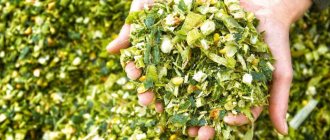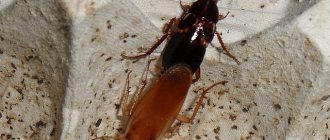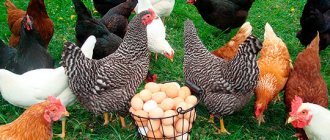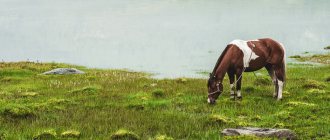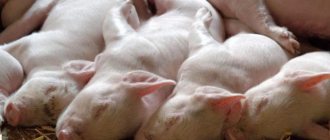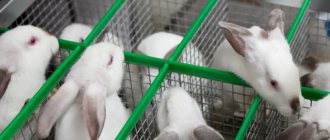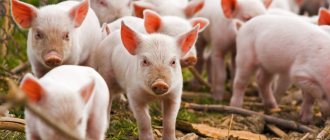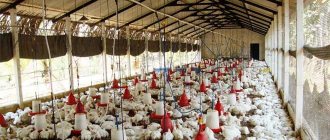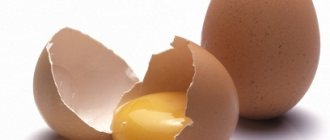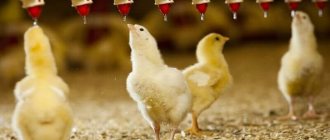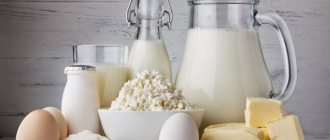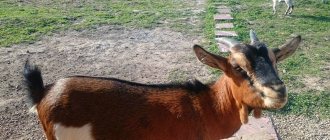Sheep can be called unique farm animals. They find food for themselves in the arid steppes, tolerate frost and heat without problems, reach commercial size in less than a year and at the same time require minimal care. In addition, certain productive breeds produce offspring every seven to eight months.
Such outstanding qualities provide a clear answer to the question of whether sheep breeding as a business is profitable or not. In fact, if you sell all the farm’s products, you can get 20–25 thousand rubles in income per year from each head. But an entrepreneur must realize that without understanding the specifics of sheep farming and the intricacies of organizing commercial activities, it is extremely difficult to achieve success.
Why raise sheep?
Why does sheep breeding as a business deserve the attention of farmers? The fact is that these animals provide many products that have accompanied human society for many millennia. Among them:
- Meat. Excellent lamb, without which it is impossible to cook pilaf, shish kebab, kebab, khinkali. From the animal carcass, 35–40% of a pure product without bones is obtained;
- Wool. Used in the production of warm clothing. A meat sheep can shear 5 kg of wool, while fine wool sheep yield more than 12 kg per year;
- Skin. From a medium-sized animal, 20–30 dm² of warm and practical sheepskin is obtained, which is used for sewing outerwear and shoes;
- Milk. The yield from a three-year-old sheep is 120–160 liters per season. From milk with a fat content of more than 5%, delicious cheeses, feta cheese, yoghurts and butter are obtained;
- Fat. In cooking it is used to prepare Asian dishes, and in medicine - to treat arthritis and bronchitis. The fat tail of a sheep contains up to 30 kg of product;
- Smushki. This is the name given to the skins of three-day-old lambs, covered with thin wavy wool. They are very expensive and are used for sewing clothes;
- Manure. The waste products of herbivores contain a set of nutrients necessary for plants. One sheep produces 3 kg of manure per day.
Why sheep
Sergei and I discussed which livestock sector could bring real income. Pig farming - not immediately due to the unstable situation with ASF (African swine fever - note "About business"). To raise cattle (cattle), considerable land is needed. They decided to place their bet on sheep breeding, an undervalued industry. Among its advantages:
- Relatively fast payback period - 3 years
- The need for feed is not as high as, for example, when raising cattle
- Getting wool as a bonus
One of the main problems is product sales. We studied the market, talked to networkers and realized that there is a demand for meat, and it is quite high, but there is little supply. Of course, there is farmed lamb in the country. But there is no supplier who would provide the required volume, timely deliveries and stable quality. So it turns out that you rarely see Belarusian lamb in stores; it costs 15 rubles per 1 kg. Imported meat in vacuum packaging is better in quality, but also several times more expensive - about 40 rubles. Don’t forget that the cost of the latter includes costs for logistics, supplier margin, and marketing. I am sure that a Belarusian farmer can offer a product no worse, but at a lower price. However, we must take into account the rules of the game in this market.
The culture of lamb consumption in Belarus is not developed. After the Chernobyl disaster, sheep began to be exterminated, because... how animal fur accumulated radionuclides. If before the accident there were 1 million sheep in the country, now there are about 100 thousand. And that number has grown significantly in recent years.
Obviously, Belarus alone will not be enough. But literally 700-800 km from us there is an immense market - two large “Muslim” cities of Moscow and St. Petersburg. To get there, the manufacturer must take into account the canons of Islam and adjust production processes, equipment, documentation, storage facilities, raw materials, ingredients and even personnel to them. Is the game worth the candle? I think yes. A company that enters these markets with new high-quality products will play alone, since there is practically no competition.
Features of sheep farming as a business
Thirty to forty years ago, sheep farming was one of the leading branches of agriculture, especially in the Volga region and Central Asia.
During political cataclysms, collective farms and large farms went bankrupt, as a result of which the livestock of small animals decreased fourfold. Currently, the number of animals in Russia is growing again by 2–3% per year, but this is happening mainly due to private and subsidiary farms. Therefore, raising sheep at home as a business has some prospects for beginning farmers who have fertile pastures at their disposal. These are found in abundance in the following regions:
- Ciscaucasia and Caucasus;
- Stavropol and Krasnodar Territories;
- Tatarstan, Chuvashia, Kalmykia;
- Saratov, Volgograd and Astrakhan regions;
- Bashkiria, Orenburg and Chelyabinsk regions.
In the USSR, wool was considered the main product of sheep farming. However, along with the collective farms, the processing plants that purchased raw materials from the population also disappeared. Therefore, farmers today have no choice but to focus on the production of meat and milk, because organic products are actively becoming fashionable. There are other reasons explaining the relevance of this industry:
- Lambs gain 300 g of weight per day, and by the time of slaughter at ten months they already have a marketable weight of 50–70 kg;
- Sheep of productive breeds can give birth to one or two babies twice a year for eight years;
- Adapted animals make do well with a meager food supply and tolerate frosts down to –25°C without harm;
- In Russia, sheep are almost not bred on an industrial scale, and therefore the farmer does not have to fear competition;
- The state considers sheep farming a priority industry, which allows you to think about how to get a grant for farming development.
Pedigree sheep breeding
For new farmers, an important question when raising sheep is what breed can be raised.
Three types of sheep are popular in Russia:
- Meat-greasy
- this includes the Astrakhan and Kazakh breeds. These breeds have good weight and gain weight quickly. - Meat
breeds include Texel, Suffolk and Zwartbles. These animals reproduce well and quickly get used to the climate of central Russia. They grow quickly. A one-year-old sheep can already be sold. - Romanovsky
is the most popular species in Russia. Sheep grow very quickly and produce good offspring. Withstands temperatures down to -30°C. Males are used for meat, and females are used for breeding.
What breeds of sheep should I raise?
In Russia you can find more than sixty different breeds of small cattle.
To determine which sheep are best for breeding for meat, wool or milk, you need to consider their classification: 1. Coarse wool. They have a hard and heterogeneous cover, consisting of down and guard hairs. Among them there are breeds:
- Fur-meat. They are fertile and produce good sheepskin;
- Smushkovye. They are bred mainly to produce smishkas.
2. Meat-greasy. Large individuals that produce a lot of meat and fat tail.
3. Meat and wool and dairy. They produce warm fluffy wool and a lot of milk.
4. Semi-coarse-haired. Their coat contains more fluff and less coarse hair. The animals are also distinguished by good meat and fat productivity.
5. Fine wool. They have thin and thick white wool up to 15 cm long, which is valued in industry. Breeds are divided into:
- Woolen. They become very overgrown due to the presence of skin folds;
- Wool and meat. They produce less wool with good meat productivity.
6. Meat-haired. They have no folds at all, but differ in muscle mass.
7. Semi-fine fleece. Their fur is a little thicker, but just as long and beautiful. They have a massive body and a wide back. The category includes breeds:
- Long-haired. Their characteristic feature is long shiny fur;
- With semi-luster wool. The villi are just as uniform, but less shiny.
8. Short-haired. They have dense, warm wool up to 10 cm long.
The best sheep breeds for breeding in Russia are distinguished not only by high productivity, but by good adaptation to the peculiarities of the local climate:
Sheep breeds for breeding
| Name | Type | Weight, kg | Cut, kg | Fertility, % | ||
| Barana | Sheep | Barana | Sheep | |||
| Altai | semi-coarse-haired meat-haired | 100 | 60 | 12 | 6 | 150 |
| Vendée | rough-haired meat-haired | 150 | 80 | 6 | 4 | 130 |
| Gissarskaya | rough-haired meat-greasy | 140 | 80 | 2 | 1,5 | 120 |
| Caucasian | fine wool wool and meat | 115 | 60 | 9 | 4 | 140 |
| Karakulskaya | rough-haired smushkovaya | 90 | 50 | 5 | 2,5 | 120 |
| Kuibyshevskaya | semi-fine wool meat-wool | 110 | 65 | 7 | 4,5 | 130 |
| Merino | fine wool meat wool | 115 | 55 | 13 | 7 | 130 |
| Romanovskaya | rough-haired fur-meat | 120 | 65 | 5 | 2 | 230 |
| Romney March | semi-fine wool meat-wool | 120 | 80 | 13 | 6 | 120 |
| Stavropolskaya | fine wool wool | 110 | 60 | 19 | 8 | 120 |
| Texel | semi-fine-fleece meat | 140 | 80 | 6 | 5 | 130 |
| Tsigaiskaya | semi-fine wool meat-wool | 90 | 50 | 8 | 4 | 130 |
| Edilbaevskaya | rough-haired meat-greasy | 120 | 75 | 5 | 2,5 | 120 |
Where to buy livestock
When breeding sheep, it is necessary to carefully select the stock. You cannot buy animals from private owners who keep 100-200 heads, as they often sell defective rams, for example, with cryptorchidism (with this disease it is impossible to procreate). Outwardly, the animal will look healthy and will even attempt intercourse, but this will be of little use, since the ram will be completely infertile.
Therefore, you need to buy livestock from farms that have veterinary certificates and other documents that will be needed in the future, when authorities check the meat for compliance.
The cost of rams depends on the breed, as well as the place where they are raised. For example, adult animals of the fat-tailed breed can be purchased for 10-12 thousand rubles, a sheep will cost about 5 thousand rubles. Therefore, the starting investment will directly depend on which animals will be selected for breeding. Since the profitability of this business is low, keeping less than 500 head of rams is not profitable.
To breed sheep for meat, it is better to choose the Romanov breed, which is the most popular in Russia in terms of early maturation and productivity. In 7 months, the offspring of this breed can gain weight up to 200 kilograms.
Precos is a French breed of sheep and rams, raised by European breeders. Thanks to the work of specialists, individuals of this breed have high vitality and resistance to diseases. The average weight of a ram is 130-140 kilograms.
The Kuibyshev breed is also often used for breeding sheep for meat. Individuals have an impressive appearance, thick hair and excellent meat performance. They are resistant to temperature changes and can withstand cold and heat. A ram weighs on average 100-105 kilograms.
These are the main breeds of sheep suitable for breeding sheep for slaughter, with further sale of meat.
How to buy sheep for breeding?
Where to start raising sheep as a business?
Obviously, suitable breeding animals must be found. You cannot buy them on the market or in private farms, and therefore you will have to contact special nurseries that guarantee the purity of the breed. It is recommended to take sheep and rams from different breeders to exclude family ties. A beginner should not mess with lambs. It is better to purchase strong and healthy adult animals at the age of two or three years: they will be able to bring some profit for several years until the farmer gains experience. How to assess their condition:
- A productive sheep has strong bones, wide withers, a long body and straight legs. Curvature or convergence of the limbs will interfere with her ability to walk;
- The head should be of medium size. An overly wide forehead or heavy jaws are signs of a coarse constitution;
- A sheep has 6–8 front teeth on both jaws. A lack of incisors indicates old age of the animal or possible problems with feeding in the future;
- The back should be flat and wide. A sagging or hunched spine indicates defects of the musculoskeletal system;
- A healthy udder is medium in size, without compaction or granular structure. If there are hard areas, mastitis or another infection may be suspected;
- The hooves should be strong, healthy in color, and odorless. Lameness and elevated leg temperature are signs of foot rot.
Secrets of choosing young animals
Experienced sheep breeders advise carefully inspecting the animal you are purchasing, since it is easy to understand from its appearance whether the individual will grow healthy and strong.
At the age of 3 months, rams weigh on average 22 kg, and ewes - 18 kg. If a young lamb is breathing heavily and “coughing,” it means there are problems with the lungs.
A healthy lamb will have straight hooves without any chips.
It is important to examine the oral cavity and check the bite. If the teeth are incorrectly positioned, sheep will not be able to chew food thoroughly and will have problems with digestion and, as a result, weight gain.
The normal body temperature of sheep is up to 40⁰C. The pulse rate is 70-80 beats per minute.
Breeding farms provide appropriate certificates. Individuals of a certain breed should be purchased from trusted suppliers after reading the documents. The optimal time to purchase young animals is spring. By autumn the young rams will be ready for slaughter.
Methods of keeping sheep
There are four ways to raise sheep. The farmer must take into account the climate of the region and assess the availability of food resources in order to choose the optimal one among them:
- Stall. It is practiced in areas with insufficient pastures, where fields are occupied by forage crops. Animals are constantly kept in pens;
- Stall-pasture. It is used when there is a lack of winter pastures in areas with active farming. In the summer, the sheep are grazed, and in the winter - in the sheepfold;
- Pasture-stall. Suitable for regions with winter pastures and a rich food supply. The herd is driven into the sheepfold only when frost sets in;
- Pasture. Used in warm areas with winter pastures and undeveloped agriculture. Sheep graze all year round, but are also given grain in the winter.
Purchase of feed
The amount of feed depends on the farm's population. If there are fertile pastures, additional nutrition will not be needed in the summer. Suitable grasses for feeding sheep would be clover, alfalfa and bluegrass.
In winter, animals are fed oats, barley, and hay . On average, the daily diet of one sheep consists of two kilograms of straw, a kilogram of hay, and barley. You can add root vegetables, silage, and branches to the diet. For digestion, be sure to give mineral salt. In winter, animals need to be fed three times:
- In the morning they feed with rough and succulent feed: hay, carrots, beets, turnips, pumpkin, rutabaga and potatoes
- During the day they provide feed and grain crops: oats, barley, corn
- Roughage again in the evening
If the farm also specializes in selling sheep wool, then the nutrition should be more balanced and contain vitamins and microelements. In this case, concentrated feed .
How to care for sheep?
In the warm season, flocks are grazed from dawn to dusk. However, this does not mean that animals can be left unattended. Keeping and breeding Romanov sheep in any case requires compliance with some recommendations:
- The herd is sent to graze when the grass grows at least 5–10 cm. At first, before grazing, the animals are given a little hay;
- In cold weather and when there is dew, grazing is carried out only during the day. In summer, sheep are kept on pasture in the morning and afternoon, allowing them to rest in the midday heat;
- When it rains, food is provided under a shelter or in a sheepfold. The thick layer of sheep's wool takes a very long time to dry, which can cause a cold;
- The veterinarian conducts a monthly inspection of the herd, identifying weak, sick or pregnant sheep. In order not to look for them in the pasture, you can do this near a watering hole;
- When warm weather sets in in May-June, the animals are shorn. A timely procedure is especially important for fine-fleece breeds;
- To prevent scabies, sheep are bathed twice with the addition of disinfectants - a week after spring shearing and after weaning the babies;
- When grazing on dry soil, the hooves are trimmed and cleaned every month and a half. If the ground is characterized by high humidity, the procedure is carried out more often;
- As the sheep grow, the wool around the tail and on the inside of the legs is trimmed. This prevents the accumulation of dirt and the appearance of fly larvae;
- Twice a year, animals are vaccinated, skin parasites are removed, and deworming is carried out.
With the onset of cold weather, the animals are transferred to a warm room in the sheepfold. Here they sleep, but during the day, in the absence of severe frosts, they walk and feed on the site. This content helps them acquire thick hair, improves appetite and strengthens the body. In winter, breeding meat sheep includes the following activities:
- When switching to winter mode, premises and equipment are washed and treated with disinfectant solutions. The procedure is repeated again in the spring;
- If the weather permits, the sheep are fed in the paddock all winter. Feeding in the sheepfold is carried out only during rain or snowfall;
- In cold areas, the floors of the sheepfold are covered with a layer of straw. A little material is added daily after the manure has been removed;
- Feeders and drinkers are cleaned and washed of dirt weekly. Old food should not be allowed to accumulate in them;
- Every two months the sheep's hooves are cleaned. Sheep of long-haired breeds regularly have the obstructive wool around their eyes trimmed.
Purchase of equipment and machinery
The next step will be to arrange the territory and sheepfold. For the normal functioning of the farm, the necessary equipment and machinery must be purchased for 550 thousand rubles:
- A tractor worth 400 thousand rubles.
- A mower for 100 thousand rubles.
- Barricades made of bars 1 m high
- Feeders and drinkers
- Equipment: pitchforks, buckets, rakes, etc.
To save money, you can buy used equipment or rent it, and make the fencing yourself.
What to feed the sheep?
An adult sheep weighs 60 kg, and a ram weighs more than 120 kg. To meet the energy and nutritional needs of such a large animal, it must be fed intensively all year round. Of course, the diet will change according to the season:
- In spring, animals feed on fresh grass. In the morning they are given a little hay, and in the evening - grain, feed and mineral supplements;
- In summer, greens make up 95% of the diet. For fattening rams, grain and concentrates are added to the menu. Watering is done twice a day, after which the sheep are given salt;
- In the fall, as the grass withers, the herd is switched to hay, straw, vegetables, grains and combined feed, not forgetting about mineral supplements;
- In winter, sheep are kept on hay and silage. The diet also necessarily includes vegetables, grains, feed, minerals and vitamin premixes.
As you can see, in winter, raising sheep at home for beginners requires special attention to nutritional adequacy. Animals need:
- Young shoots of fruit and deciduous trees - cherry, plum, aspen, willow;
- Juicy silage from meadow grass, tops, corn, sunflower;
- Root crops and fodder vegetables - beets, carrots, potatoes;
- Grain straw and meadow grass hay;
- Cereal and legume feeds, corn grain, compound feeds;
- Loose and lick salt, chalk, bone meal;
- Water in a volume of 5–7 liters daily (depending on the weather).
During wintering, the flock is fed twice a day, and lambs up to four times. The following table will help you calculate the daily feeding rate:
Sheep feeding rate
| Product | Lambs | Young animals | Adults | Suyagnye | Nursing |
| Hay, kg | 1–1,3 | 1,3–1,6 | 1,5–1,8 | 1,9–2,2 | 1,9–2,4 |
| Straw, kg | – | 0,5–0,7 | 0,6–0,9 | 0,7–1,0 | 0,7–1,0 |
| Branches, kg | – | 0,4–0,7 | 0,6–0,9 | 0,6–0,9 | 0,6–0,9 |
| Vegetables, kg | 1,1–1,5 | 1,6–2,1 | 2,1–2,3 | 1,2–1,7 | 1,6–1,9 |
| Grain, kg | 0,1–0,3 | 0,4–0,5 | 0,4–0,6 | 0,4–0,7 | 0,5–0,8 |
| Salt, g | 4–6 | 8–12 | 8–12 | 12–15 | 12–15 |
Advantages and disadvantages of sheep farming
After analyzing the current demand for sheep products, it is worth deciding on the breed. Animals are usually divided according to a number of productivity characteristics, and as a result, groups are formed according to the following areas:
- meat;
- wool;
- meat and greasy;
- dairy
By raising sheep, you can get meat, wool, milk, and the success of the business depends on choosing the “right” breed.
The average yield of meat products is 55% of live weight. The volume of wool sheared from 1 sheep ranges from 3-11 kg, depending on the breed. Sheepskin is also on sale. From a lamb you get up to 8 dm3 of sheepskin, from an adult - up to 30 dm3.
Genetically, sheep are strong, fertile, hardy animals, so breeding them has a number of advantages:
- Resistance to infections. With timely vaccination, sheep rarely get sick.
- Resistance to changing climatic conditions.
- Easy to care for.
- Rapid growth rate of the herd, as the sheep are ready to lamb twice a year.
There are also disadvantages to sheep farming:
- Sales difficulties. There are regions where a number of stereotypes have developed about lamb; they prefer cattle and poultry meat. To reliably understand whether there will be demand, it is worth conducting a survey and talking with the managers of other farms.
- The need to find and rent pastures.
- High price for breeding individuals. Expenses for purebred representatives of the breed are justified, but at the beginning of business development they will be noticeable. Breeding representatives are necessary to obtain offspring with enhanced productivity parameters. In most cases, purebred rams and sheep of different breeds are crossed. Their offspring are distinguished by greater meatiness and early maturity.
Having compared all the pros and cons, it is necessary to draw up a business development plan.
How to raise sheep?
It is recommended to start breeding breeding sheep when they reach the age of 12–16 months, when the body weight of females exceeds 40–42 kg. Mating is carried out in the fall so that the lambs that have grown up in the spring, after weaning from their mother, immediately have access to fresh young grass. Tips for breeding sheep look like this:
- 6–8 weeks before mating, the ewes are separated from the lambs of the previous litter. At the same time, veterinary treatment is carried out and uterine groups of animals are formed;
- Mating is carried out in accordance with the reproductive cycle, which in sheep is 16–18 days. During the hunt, the female behaves restlessly and does not run away from the male;
- The duration of gestation in sheep is 145–155 days. As a result, 1–2 lambs are born;
- Three weeks before the due date, the maternity ward is cleaned, tidied up and disinfected. In winter, the greenhouse is heated to 18°C, the floor is strewn with straw;
- Two weeks before lambing, the wool on the legs and udder, around the tail, is cut off. Animals' hooves are also trimmed and treated;
- At the first hint of childbirth, a round-the-clock watch is established in the sheepfold to help the female in case of complications;
- The newborn lamb is removed from the amniotic sac, mucus is removed from the respiratory tract, and the umbilical cord is cut. The sheep must then lick it;
- The female's udder is washed with warm water and wiped dry. The first dirty portion of milk is milked into a separate bowl, after which the lamb is allowed near the ewe;
- After a couple of hours, the female is given 1.5–2 liters of warm water. In the first week she is fed hay, and later they begin to add root vegetables to her diet;
- In order for the sheep to get used to the baby, they are placed in a separate pen and kept there for 2-3 days. Later you can transfer them to the general group of suckling queens.
Mating and haircut
For the natural increase in the number of sheep, mating is used during breeding. It happens:
- Free
- occurs on farms with a small number of sheep - up to 200 heads. One ram can breed with 50 females or more. Mating is applied in July, juveniles appear in December. - Planned
- sheep are grazed in such a way that the rams are separated from the sheep. They are then brought together for 2-4 weeks for mating. This tactic requires additional costs. Since every 30 sheep will need their own shepherd. - Artificial
fertilization is the most expensive. But the lambs have high quality indicators.
Livestock shearing is carried out in 2 stages:
- In the spring, the sheep's wool is sheared so that the wool is evenly distributed;
- in spring and autumn - sheep with a heterogeneous wool type.
Before cutting the wool, you need to make sure it is dry to avoid damage during storage. Sheep do not need to be fed for 24 hours before shearing. And you should not drink for 12 hours.
It is carried out manually or using a special machine. The fleece is cleaned in a special way, and then folded.
How to raise lambs?
Breeding Romanov sheep at home is useless if you do not learn how to raise healthy and strong lambs. Of course, already on the second day after birth, the baby can stand on his feet and independently find the mother’s udder, but he cannot be left unattended:
- In the maternity ward, the temperature is maintained at 12–18°C. To prevent babies from getting too cold, the floors are covered with clean, dry hay;
- If there is a lack of sheep's milk, the lambs are fed heated goat's or cow's milk. At one week of age the daily dose is 200 g, at one month of age - 800 g;
- During the day, the females are kept and fed on a walk, and the babies are left in a warm house. To give them their mother's milk, the sheep are driven indoors every three hours;
- At two weeks of age, lambs begin to introduce bran, mixed feed, and crushed oats into their diet. They start with a portion of 50 g per day, and at three months they give 200 g;
- At three weeks, lambs have their tails docked for hygienic purposes. Rams intended for fattening are castrated;
- Older children are walked for an hour a day. In winter, the walking time should not exceed 15–20 minutes. In frost, rain or snow, lambs are not allowed outside;
- Starting from four months, milk is gradually replaced with adult foods. The females are driven away for fattening, and the babies are grazed in the cultivated meadows;
- Five-month-old lambs are divided into groups based on gender and formed into independent flocks.
Feeding and daily care
The main component of the sheep's diet is grass, fresh or dry. In summer, they need up to 9-10 kg of succulent green feed per day, in winter - 5-6 kg of hay, but it can be replaced with straw. It is forbidden to contain alfalfa or clover, they are dangerous for these animals. They need to eat about three times a day to keep their digestive tract working properly.
Salt and special mineral complexes are used as mandatory additives. It is also necessary to ensure that there is fresh water in the drinking bowls. One animal needs about two liters per day, and even more in hot weather.
Hay is prepared for the winter
Animals need daily walking for many hours. The pasture should be fenced so that the herd does not wander away, or a shepherd is hired for this. It is necessary to ensure that the rams are not injured; after serious injuries they will have to be slaughtered. In hot weather, animals are driven out early in the morning so that they have time to eat, and during the day they are necessarily transferred to the shade. A veterinarian is regularly invited to visit purebred sheep for preventive examinations. Adults take care of their horns and hooves independently.
Grass is the basis of the diet
The horns are cut down with a hacksaw if they begin to grow incorrectly and threaten the organs of vision. Hooves are cleaned and trimmed for preventive purposes, because animals spend all their time on their feet, which is why the horny growths can be damaged and cracked.
Table 3. Hoof care instructions
| Illustration | Description |
| Step one: First, the hoof is carefully cleaned of dirt. | |
| Step two: Next, cut away the peeling and cracked tissue on the front and back. | |
| Step three: as a result, the animal should confidently stand on its hoof and not experience discomfort. |
How to register a business?
For beginners, sheep breeding at home can be organized as part of a personal farm. But the legal area of 2.5 hectares is enough, at best, to feed five or six animals. Therefore, an entrepreneur who wants to receive a more significant income must create an individual entrepreneur or peasant farm using the Unified Agricultural Tax system with the following OKVED codes:
OKVED sheep breeding
| 01.45 | Sheep and goat farming |
| 01.45.2 | Production of raw sheep and goat milk |
| 01.45.4 | Breeding sheep and goats |
It is impossible to breed sheep in Russia on an industrial scale without the approval of various authorities. To do this, you need to notify Rospotrebnadzor about the start of the enterprise’s activities and formalize:
- Project documentation for the farm;
- Permission from the local administration;
- Permits from the sanitary department and environmentalists;
- Permission from the fire department;
- Veterinary passports of animals;
- Certificates for meat and milk;
- VSD forms No. 2 and No. 3 for batches of meat and milk.
Finally, breeding meat sheep requires registration and subsequent entry into the invoice system for the shipment of goods. To do this, you need to obtain an electronic signature and log in to the site.
Prospects for sheep farming in Russia
Experts assess the time to start your own sheep farming business as generally favorable. Today, competition in this segment is minimal: sheep farming in our country is still in crisis. The number of livestock, according to research, until recently was rapidly declining every year. However, now the situation is gradually changing. About 10 million sheep belong to private households in Russia, about five million animals belong to agricultural enterprises, and only a little more than one million belong to farms. Two years ago, the total number of sheep and goats in our country was 24 million heads. Compared to previous years, there is a trend of slow but steady growth. Moreover, the largest increase in the number of sheep is observed in the North Caucasus and Southern Federal Districts.
However, such a “territorial” connection is quite understandable. Although sheep themselves are quite unpretentious, not the entire territory of the Russian Federation is suitable for their breeding. First of all, the main conditions for the development of sheep farming are the presence of free pastures and the predominance of tropical and subtropical zones.
The following regions meet the criteria for the development of sheep breeding in our country: the North Caucasus, the Southern Federal District, the Volga region, the Central Black Earth region and the southern part of the Urals. It is these territories that are the largest sheep breeding areas in Russia.
Each region has its own “specialization”. The breeds of sheep that are bred in a particular region directly depend on its natural conditions. Thus, in the Central Black Earth region, fine-wool sheep breeding is common, and in the mountainous regions of the North Caucasus you can find the most coarse-wool sheep. In the Southern Federal District, valuable breeds of semi-fine-wool sheep predominate, and in the Orenburg region they are engaged in coarse-wool smushko and meat-fat sheep breeding.
That is, in the steppes and semi-steppes, fine-fleece breeds predominate. Wetter and milder climatic conditions are suitable for breeding fine-fleece and meat-wool breeds. Cold and mountainous regions provide more favorable conditions for meat-dairy and meat-fat coarse-haired breeds. Smushkovo sheep breeding in Russia is concentrated in desert and semi-desert regions. In general, sheep farming is most developed in the North Caucasus, which is due to the presence of large areas for sheep grazing and at the same time a low percentage of the urban population.
Sheep raising area
Breeding Romanov sheep as a business will not be profitable in the absence of a natural food supply, since an adult animal eats at least 12 kg of fresh grass per day. Therefore, the farmer should consider buying or renting a plot of land with rich pastures. When choosing it, you need to consider the following criteria:
- Distance to cities and villages where it is possible to hire workers;
- Presence of organizations polluting the environment nearby;
- Prices for land for purchase or rent;
- Availability of access roads, power lines, water supply;
- The nature and volume of the food supply;
- Distance to bodies of water suitable for drinking;
- The presence of buildings that can be converted for your own purposes.
For raising sheep at home, you can use any areas except salt marshes and swamps. To prevent depletion of pastures, their rotation or artificial cultivation is organized. Taking into account the growth rate of the grass cover, for each animal there are:
Grazing standards per sheep
| Pasture type | For a month, ha | For the season, ha |
| Tall cereal grasses | 0,20 | 0,60 |
| Low cereal grasses | 0,35 | 1,05 |
| Semi-desert cereals | 0,45 | 1,35 |
| Cereals and wormwood of the semi-desert | 0,75 | 2,25 |
| Pine-juniper undergrowth | 0,70 | 2,10 |
| Shrubs | 0,80 | 2,4 |
| Rare deciduous undergrowth | 0,65 | 1,95 |
Where to start a business: searching for pasture
First of all, you need to find pasture where the herd will feed. Actually, the organization of a farm begins with the search for pastures. When planning, it is important to correctly calculate the required amount of land; for this you can take the following formula from the textbook “Use of Pastures on Sheep Farms”:
G = U/N x P.
- G is the number of heads per hectare.
- Y is the yield of consumed grass per 1 hectare, multiplied by the percentage of grass stand use. The percentage depends on the type of pasture. The pasture can be natural, then we take the figure 50-60 percent, improved natural (70-80%) or artificial (80-90%). The harvest depends on the type of grass, on average 100 centners.
- N – daily rate of grass per sheep (10 kg).
- P – duration of use of this pasture.
Having calculated the number of sheep in the herd, you need to acquire the necessary space.
Various types of natural pastures are used for grazing sheep:
- Steppe pastures.
On virgin steppe pastures, green grass appears first, so such pastures begin to be used earlier than others. The grass stand consists mainly of feather grass, sheep's fescue, thin legged grass and forbs. In summer, steppe pastures burn out, but in autumn they are again covered with green vegetation. Thus, they are used for early and late grazing. The norm per sheep is 0.1-0.2 hectares.
- Steppe semi-desert pastures.
In Central Asia, livestock is traditionally grazed on steppe semi-desert pastures. There is little precipitation, wormwood, camel thorn, and sandy oats grow there. In the summer months, animals have to eat dry grass, so the sun burns all the vegetation.
- Mountain pastures.
The best natural pastures are mountain pastures where legumes and cereal plants of high nutritional value grow.
Don’t complicate your task and build a farm from scratch. The situation in the Russian livestock industry is still quite difficult. The southern rural areas are full of empty farms with dilapidated paddocks and stalls. But it is easier to restore existing pens than to rebuild them from scratch. It also makes no sense to make a heating system in a sheep pen: sheep tolerate cold well. During abnormal frosts, when the temperature drops to extremely low levels, you can put a potbelly stove in the pen. All the same, the costs will be much less than when equipping a heated room for keeping animals.
Keep in mind that it is almost impossible to fatten sheep to the required weight on grass alone in some areas of the country. Therefore, you will have to buy grain. The further north you go, the more expensive it will be to feed and maintain sheep, so calculate in advance the profitability of the enterprise, taking into account the increasing costs of preparing feed, veterinary care for animals, and carrying out sanitary measures in premises during long-term stabling (in the north, grazing is possible only during the period from mid-May to September).
Artificial pastures and advanced feeding patterns
Modern livestock breeders consider it beneficial to create artificial pastures that are sown with annual and perennial grasses. Sudanese, sorghum, vetch-oat mixture, mogar, and winter rye are used for annual crops. On perennial pastures, alfalfa, clover, sweet clover, sainfoin, wild grass, fescue, and bluegrass are sown.
Advanced farmers are trying to improve the system of feeding and use of pastures. What are the advantages of the new approach? Firstly, land that has been taken out of crop rotation can be used for pastures to restore fertility. Secondly, the number of sheep that can be fed on pasture increases significantly.
This happens as follows. The field is sown with alfalfa. The area is fenced off, the grass on it is mowed at lunchtime and laid out in the same area in feeders, each feeder for 20 heads. The animals are kept in a designated area until nightfall; in the morning they are released to finish eating grass until 11 o’clock in the afternoon. By lunchtime, the sheep are again herded into the shed, and they feed on grain from floor feeders. At this time, the next section is being prepared, and the mowed area begins to recover. Sheep go to the alfalfa feeders in the evening. This regime during the summer allows you to protect the livestock from heat stroke during the hot period and from getting wet during the rain.
Now we count. 100 centners of alfalfa grow on one hectare. A sheep eats 10 kilograms of grass per day, which means that one hectare can feed a herd of 1000 heads in a day. By fencing areas, the herd is easy to control. To graze 1000 sheep, 50 hectares of sown land are enough. In one day, the herd will gain 16 thousand rubles. In six months this is 2 million 880 thousand. By the end of the grazing period the land will be fertilized with sheep manure and ready for subsequent seeding.
Shepherd premises
In temperate and cold climates, a sheep farm cannot do without a warm room for wintering animals. Sheepfolds are usually built from wood or adobe, but to save effort, you can use a ready-made hangar. Its dimensions are determined by the hygienic standards of the area:
- Sheep and lamb - up to 5 m²;
- Suyagna uterus - up to 1.5 m²;
- Breeding ram - up to 4 m²;
- For a one-year-old lamb - up to 1 m².
When reconstructing a finished building or constructing a building from scratch, it is necessary to adhere to the standards established by RD-APK 1.10.03.02-12:
- The sheepfold is built with its back facing the cold winds. On the opposite side, a walking area is set up at the rate of 5 m² per head;
- A quarantine box with a capacity of 1–2% of the livestock is constructed at a distance of at least 100 m from the main building;
- In the warmest part of the sheepfold there is a maternity ward, divided into pens by wooden panels. Its capacity is 30% of the livestock;
- Next to the walking area, they dig a bath for washing sheep - a concrete trench 1 m deep, 0.7 m wide and 15 m long;
- Floors in sheepfolds are made of soil or clay, and in cold climates - from boards. To avoid flooding, they should be 10–15 cm higher than the soil;
- The business plan for sheep breeding includes the purchase or production of wooden shields used to separate groups of animals inside the sheepfold;
- Windows with ventilation capabilities are installed at a height of at least 1.2–1.3 m from the floor. Artificial lighting is also provided in the room.
The maternity ward, and in cold climates the entire sheepfold, is heated using electric or solid fuel stoves. The following conditions are supported internally:
Microclimate for sheep
| Parameter | Sheepfold | Teplyak | Young stock workshop |
| Temperature, °C | 3–8 | 12–18 | 6–12 |
| Humidity, % | 60–70 | 60–70 | 60–70 |
| Air exchange per 1 kg of weight: | |||
| Summer, m³/h | 0,7–0,9 | 0,4–0,7 | 0,5–0,8 |
| In winter, m³/h | 0,3–0,5 | 0,3–0,6 | 0,3–0,5 |
Organizational plan
When planning a sheep breeding business, it is important to think in advance about which site to choose for development, how to properly organize the farm, and how many staff you need to hire. In addition, an important point is the official registration of the enterprise.
Registration of activities
Registration of a farm is a mandatory step if the breeder plans to sell meat and wool in large volumes. But first, if a beginner has enough pastures with an area of up to 2.5 hectares and does not plan to sell large quantities of products, you can try your hand at private farming. Such activities do not require official registration. In addition, the owner of the farm in this case is exempt from paying taxes.
If the breeder immediately plans to breed sheep to make a large profit, rent large areas of land, cooperate with large factories and restaurants, it is necessary to register as an individual entrepreneur. Also, for normal operation of the enterprise, permits from the fire inspectorate and sanitary and epidemiological station are required.
Search and lease of land
At the initial stages of business development, it is better to rent land for building a farm and grazing sheep. This option requires less investment. At the same time, the choice of site should be approached with particular care.
It is important to choose the optimal grazing area. At least one hectare of land will be allocated for one animal from the herd. The pasture should be located close to the paddocks and sheepfolds so that the flock does not have to take a long time to move. In addition, the entire farm area with grazing must be sufficiently remote from populated areas.
Farm construction
To organize your own farm, it is not at all necessary to build it from scratch. Since the times of the USSR, a large number of abandoned farms with suitable sheds and paddocks have remained in the country. Restoring them is much easier than rebuilding them.
Only light needs to be brought from communications into the room. There is no point in installing an expensive heating system, since sheep are reliably protected from the cold by wool. To be on the safe side, a potbelly stove is installed in one of the corners.
Important! When organizing a farm, you need to build storage for feed and tools, as well as a slaughterhouse, next to the pens. Such buildings will greatly simplify the activities of the breeder.
Purchasing young stock
Before purchasing a stock of young sheep, it is important to decide which breed is needed. To do this, they analyze in detail competition in the region, its climatic conditions, and the relevance of a particular product in the local market.
Animals are purchased exclusively from trusted suppliers. Before purchasing, it is important to find out how long the supplier has been selling sheep and ask former buyers about his reliability.
When purchasing young animals, be sure to pay attention to the following points:
- lamb fatness;
- general health and past illnesses;
- whether the children’s parents were sick and what exactly;
- compliance of the exterior characteristics of young animals with the stated breed standards.
If the breeder plans to sell meat products, then all animals are registered after purchase.
Recruitment of personnel to work on the farm
Although caring for sheep does not involve any particular difficulties, a farmer will not be able to cope with a large population on his own. In this case, it is necessary to hire additional staff. The minimum staff must include the following employees:
- shepherd;
- handyman (responsibilities include feeding the flock and cleaning the pens);
- milkmaid.
Also, for a large farm, you should definitely hire an experienced veterinarian and shearer. In small farms, their services can be used periodically without full-time hiring.
When choosing shepherds, you should expect that for each worker there should be no more than 50 heads of livestock.
Sheep breeding equipment
To create a business plan for raising sheep for meat, you need to understand what equipment the farmer will need. An example would be a specification for a farm of 100 breeding sheep. One part of the equipment will be used for animal care, and the other for processing livestock products:
Equipment for sheep breeding
| Name | price, rub. | Quantity, pcs. | Amount, rub. |
| Sheepfold | |||
| Feed tray | 1500 | 10 | 15000 |
| Drinking bowl | 1800 | 10 | 18000 |
| Hay manger | 2000 | 10 | 20000 |
| Bucket for feeding lambs | 1600 | 2 | 3200 |
| Bottle with nipple | 800 | 2 | 1600 |
| Hair clipper | 6400 | 2 | 12800 |
| Hair cutting scissors | 1000 | 2 | 2000 |
| Hoof knife | 1200 | 2 | 2400 |
| Birkovatel | 1900 | 1 | 1900 |
| Head support | 4000 | 1 | 4000 |
| Milking machine | 22700 | 2 | 45400 |
| Milk fat meter | 700 | 1 | 700 |
| Milk cooler | 118000 | 1 | 118000 |
| Udder washing bowl | 300 | 5 | 1500 |
| Milk can | 1500 | 10 | 15000 |
| Fence shield | 1200 | 20 | 24000 |
| Equipment for cleaning pens | 4000 | 1 | 4000 |
| Fan for ventilation | 3500 | 2 | 7000 |
| Water pump | 4000 | 1 | 4000 |
| Solid fuel boiler | 39000 | 1 | 39000 |
| Grazing | |||
| Feed tray | 1500 | 10 | 15000 |
| Hay manger | 2000 | 10 | 20000 |
| Drinking bowl | 1800 | 10 | 18000 |
| Feed shop | |||
| Grain crusher | 3600 | 1 | 3600 |
| Feed cutter | 17000 | 1 | 17000 |
| Garden cart | 2000 | 1 | 2000 |
| Other equipment | |||
| Refrigerated vehicle | 490000 | 1 | 490000 |
| Water heater | 9800 | 1 | 9800 |
| Fat melter | 109000 | 1 | 109000 |
| Knives for cutting carcasses | 8000 | 1 | 8000 |
| meat box | 300 | 30 | 9000 |
| cooling chamber | 58000 | 1 | 58000 |
| Wool cleaning tool | 10000 | 1 | 10000 |
| Wool bag | 200 | 50 | 10000 |
| Veterinary scales | 20000 | 1 | 20000 |
| Total: | 1138900 | ||
Documents and licenses
The most profitable option is to register a peasant (farm) enterprise. This form does not require the creation of a legal entity. The registration process is similar to registering an individual entrepreneur. Prepare the following documents:
— application for registration of peasant farms; — original and copy of passport and birth certificate; — registration document from your place of residence; — receipt for payment of state duty; — land lease agreement or documents confirming ownership.
For the official sale of products, it is necessary to obtain opinions and certificates from the SES and veterinary service. Find out the requirements of these organizations before building a farm.
Sheep farm employees
Despite the unpretentiousness of the animals, raising sheep at home as a business is a rather labor-intensive task.
The farmer can handle a flock of ten heads on his own, but for a large herd he will need the help of a shepherd. The latter must be a master of his craft, otherwise he will not be able to simultaneously perform the functions of a shepherd, livestock specialist, shearer and slaughterer. To perform other tasks, auxiliary workers should be hired. You need to conclude a service agreement with a veterinarian, and an entrepreneur can master simple accounting on his own:
Sheep farm workers
| Job title | Rate, rub. | Qty | Amount for the year, rub. |
| Shepherd | 20000 | 1 | 240000 |
| Helper worker | 14000 | 2 | 336000 |
| Payroll tax | – | – | 172800 |
| Veterinary service | 4000 | – | 48000 |
| Total: | 3 | 796800 | |
Hiring
To operate a sheep farm you need to hire the following staff:
- Manager who is responsible for organizational activities
- Shepherd looking after herd on pasture and young animals
- Milkmaid collecting milk
- Veterinarian monitoring the health status of sheep
- Tractor driver
- Helper worker
- Part-time or outsourced accountant
- Visiting haircut specialist
Employees must have appropriate education and farm work skills. The number of personnel depends on the size of the sheepfold and the number of livestock. It is enough to hire 4 workers for a mini-farm.
How to sell sheep?
The main products of the sheep farm are meat, milk, wool and hides. To obtain lamb and sheepskin, young animals are slaughtered at 10–11 months. Sheep give milk while feeding the lambs, that is, 4–6 months a year, and shearing is carried out once or twice a season. All this can bring income to the farmer.
Comparing keeping sheep with a business such as breeding bulls for meat, it should be noted that lamb is insufficiently popular in Russia. Therefore, the entrepreneur will have to make significant efforts to organize the sale of his goods. What to do:
- You should submit your proposal to the city's catering establishments. Popular cafes and kebab shops can take a whole carcass daily;
- If a farmer is willing to provide a daily supply of 200–300 kg of lamb, he should negotiate with grocery stores and supermarkets;
- Milk can be sold to wholesalers or directly to dairies. But if a farmer organizes his own production of products from it, he will earn more;
- To sell meat and milk to ordinary citizens, pavilions should be opened at food markets. Of course, the stalls must be equipped with refrigerators;
- Entrepreneurs engaged in businesses such as goat and sheep breeding can take animals to a meat processing plant. However, prices here will be low;
- To attract wholesale buyers, you need to register on special trading platforms on the Internet. A large farm may even have its own website;
- After processing, it is easiest to hand over the skin and wool to ateliers, tanneries and light industry enterprises.
Demand and competition analysis
The first step of a business plan is to research the market for the demand for products and the presence of competitors, their number and pricing policy. At the moment, there is little competition in sheep farming, and demand remains high, which provides good prerequisites for scaling the business.
Not only lamb is in demand, but also wool, sheep cheese and milk. People are willing to buy natural farm products. After analyzing the market situation, they determine the breed for breeding, the size of the livestock and the area of the sheepfold.
Sheep farming business plan
You cannot consider sheep farming as a business without assessing the capital intensity of the farm. First of all, the entrepreneur must determine the size of the future herd and imagine the technology for keeping animals:
- For a small farm you need to purchase a hundred sheep at a cost of 8,000–9,000 rubles and two stud rams at a cost of 15,000–20,000 rubles each;
- If mated after purchase, the ewes will produce around 160 lambs within five months. Ten months later, the young animals are slaughtered;
- A couple of months after the birth of the babies, a second mating can be carried out. The new group of lambs will reach slaughter weight in the 22nd month.
Accordingly, the expenditure part of the business plan for breeding Romanov sheep on a leased plot of land will look like this:
Investments in business
| Article | Amount, rub. |
| Registration of individual entrepreneur or peasant farm | 800 |
| Account registration | 2000 |
| Shepherd hangar, 400 m² | 950000 |
| Arrangement of pens | 300000 |
| Equipment | 1138900 |
| One hundred breeding sheep | 800000 |
| Two stud rams | 40000 |
| Preparation of veterinary documents | 10000 |
| EDS for the Mercury system | 3000 |
| Household expenses | 16000 |
| Total: | 3260700 |
Trying to figure out which animals are profitable to breed for business, a farmer will probably want to know how much it will cost him to maintain a flock. Since the entrepreneur will have to wait until the lambs grow up, it is necessary to calculate the expenses of the sheep farm for two years:
Sheep farm expenses for two years
| Article | Amount, rub. |
| Contributions of individual entrepreneurs (peasant farms) | 72480 |
| Account servicing | 14400 |
| Rent of land, 100 hectares | 200000 |
| Salary | 1593600 |
| Public utilities | 60000 |
| Hay and straw | 144000 |
| Oats and barley | 455000 |
| Salt | 10000 |
| Boiler fuel | 96000 |
| fuels and lubricants | 72000 |
| Vaccination | 48000 |
| Product certification | 36000 |
| Seeds for pastures | 24000 |
| Total: | 2825480 |
Location
The main criterion for finding a place for a farm is land for pasture. To feed one sheep and its offspring for a year, about 1 hectare is needed. All calculations are carried out based on this indicator. If you do not own pasture land, you will have to look for land that is available for rent. Abandoned farms and the territories of bankrupt state farms are suitable.
Please pay attention to the term of the contract and the conditions for its extension. It is important to enter into an agreement for a long period; discuss the possibility of purchasing the land. It is very important.
Profitability of sheep breeding
It is difficult to say unambiguously what income will be generated by breeding Romanov sheep as a business: the result depends on the availability of a replenishable food supply. If the farmer solves this problem, then in 10 months he will get animals weighing 60–70 kg from lambs. Revenue will come not only from their slaughter, but also from the sale of wool and milk:
Sheep farm revenue for two years
| Product | price, rub. | 15th month, pcs. | 22nd month, pcs. | Total, rub. |
| Meat, 35 kg | 300 | 160 | 160 | 3360000 |
| Wool, 4 kg | 80 | 262 | 262 | 167680 |
| By-products, 3 kg | 150 | 160 | 160 | 144000 |
| Milk, 120 l | 100 | 100 | 100 | 2400000 |
| Skin | 600 | 160 | 160 | 192000 |
| Total: | 6263680 | |||
Comparing farm income with expenses, we can assume that the profitability of sheep breeding will be quite high. Indeed, if there are distribution channels, investments in the enterprise will pay off in just two years:
Profitability of sheep farming
| Index | Meaning |
| Revenue for 24 months, rub. | 6263680 |
| Expenses for 24 months, rub. | 2825480 |
| Profit, rub. | 3438200 |
| Tax, rub. | 206200 |
| Net profit, rub. | 3232000 |
| Profitability, % | 114,4 |
| Capital investments, rub. | 3260700 |
| Payback period, years | 2 |
Investments and income of a sheep farm
So, to organize a small farm with a herd of 300 sheep, the following expenses will be required:
- Renting land space will cost from 150 thousand rubles.
- For construction and/or renovation of premises – from another 100 thousand rubles.
- The salary of farm workers will be from 700 thousand rubles per year.
- Overhead costs – from 80 thousand rubles per year.
Add to this the cost of buying sheep and feed. The cost of a sheep is determined by the purity of its breed, weight and age. For example, for Romanov breed sheep the price is about 250-300 rubles. per kilogram of live weight. Fat-tailed lambs weighing 30-40 kg are sold at a price of 120-220 rubles. per kilogram. Breeding animals cost 5500-8000 rubles for a lamb and 8000-12000 rubles for a ewe. You cannot do without a spacious transport; you will need to transport sheep, meat, hay, grain, and tools on it. Thus, to organize a farm you will need from 1 million rubles.
Income consists of the sale of live sheep (from 500 thousand rubles per year, based on one hundred heads at 5 thousand rubles per head), the sale of meat (another half a million rubles per year), the sale of wool (from 100 thousand rubles). The payback period for such a business is two years.
Breeding as a business
If you plan to organize a breeding farm and purchase a thousand animals at once, then in this case you will need about 8 million rubles for the purchase of breeding stock, 1.5-2 million rubles for the development and support by a specialist of documentation for obtaining the status of “Breeding Producer”, up to 10 million rubles for the construction of a fattening complex, the opening of a meat processing plant with a slaughterhouse and a semi-finished products workshop. Such a livestock requires 4.5-5 thousand hectares of pasture land and 80-100 hectares of hayfields. In total, the costs will be about 25 million rubles. The payback period for such a project is about five years (taking into account 100% lambing and working with partners on prepayment).
Sheep farming as a seasonal business
Sheep farming cannot be classified as a seasonal business, however, some entrepreneurs, having sufficient pasture areas in their own possession, are engaged not in breeding, but in fattening lambs with their subsequent resale. In the spring, they buy lambs for rearing at 120 rubles per kilogram of live weight (one four-month-old lamb weighs about 30 kg). By autumn they fatten them up to 60-65 kg and sell them. The difference minus the feed is the profit. In this case, experts advise not to take lambs younger than four months and not much older, since older animals gain weight worse, and accordingly, fattening them for subsequent resale will not be so profitable.
Sysoeva Lilia
(c) www.openbusiness.ru - portal of business plans and guides for starting a small business
07/15/2015
All materials tagged: livestock farming
Calculator for calculating the profitability of this business
Net profit (monthly):
Payback period:
Profitability:
More detailed calculations can be made in our free application
Save the article to study the material carefully
Remember article
You can save this page using:
Search and selection of personnel
To get a good start, even at the stage of searching for territory for pasture and premises for keeping, think about personnel. With a small herd of up to 200 sheep, you can cope with the functions of a shepherd on your own. Other specialists are hired periodically for one-time work. For example, shearing sheep is a seasonal procedure.
With an impressive livestock, the following specialists will be required: shepherd, manager, livestock specialist, veterinarian, shearer, milkmaid. It may be more profitable to hire a universal specialist who can handle these functions himself.
How to organize a pasture and sheepfold
As mentioned earlier, sheep spend more time on pasture, so due attention must be paid to finding a good place. Usually, the norm is taken to be 1 hectare of pasture per individual; this area is needed for one year. Thus, after simply multiplying the livestock by the norm, you can get the approximate area of the pasture.
Pasture organization
As for the sheepfold, no special buildings are required; the premises should be as simple as possible. If the home sheep farm is located in a village or village, then an ordinary wooden barn or an old home farm will do. You don’t even have to equip the sheepfold with a heating system, since the sheep can withstand harsh winters quite well. If the winter is especially cold, you can get by with an ordinary potbelly stove.
